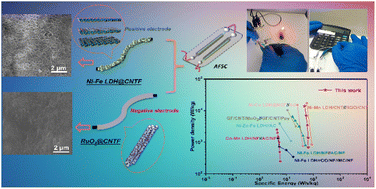Hierarchical layered nickel–iron double hydroxide/carbon nanotube fiber electrode for constructing asymmetric fiber supercapacitor†
Abstract
Emerging fiber-shaped supercapacitors (FSC) provide a promising approach for the demands of flexible energy storage devices for portable and wearable electronics. However, efforts to seek solutions to obtain highly electrochemically active materials without compromising flexibility are required. Given this, in the present work, aligned carbon nanotube fiber (CNTF) is synthesised and applied as a flexible substrate and excellent current collector. Moreover, nickel–iron layered double hydroxides are grown in situ on the CNTF (Ni–Fe LDH@CNTF) by a hydrothermal reaction. This strategy integrates the respective advantages of these two materials and leads to a high specific capacity of 248.9 mA h g−1 (1 A g−1) for the obtained composite fiber electrode. Moreover, an asymmetric supercapacitor (ASC) constructed with the Ni–Fe LDH@CNTF positive electrode presents a high energy density of 64.35 W h kg−1 at a power density of 699.88 W kg−1, outperforming most of the previously reported carbon-based supercapacitors. The corresponding all-solid-state asymmetric flexible supercapacitor (AFSC) can easily power electronic devices even when subjected to bending. Thus, the present supercapacitor design philosophy provides a promising solution to the demands for power sources for flexible and lightweight electronic devices.



 Please wait while we load your content...
Please wait while we load your content...